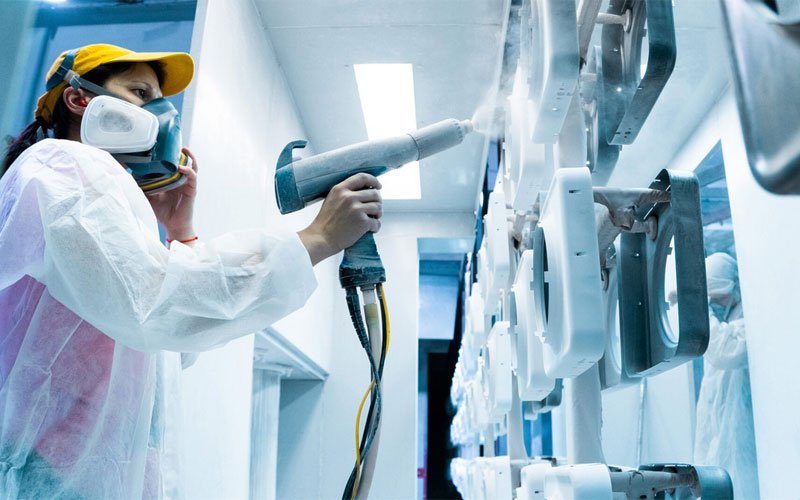Powder coating ovens have come a long way from their humble beginnings. What started as a basic tool for applying protective and decorative finishes has evolved into a sophisticated piece of machinery that plays a crucial role in modern manufacturing. Today’s powder coating ovens are marvels of engineering, designed to meet the ever-growing demands of precision, efficiency, and customization in various industries. In this blog, we’ll take a closer look at how these ovens have evolved over the years, transforming from simple heat boxes into high-tech wonders.
Early Powder Coating Ovens and Their Basic Functionality
In the early days, powder coating ovens were pretty straightforward. Their main job was to bake the powder coating onto a surface, creating a smooth, durable finish. These early ovens were essentially large metal boxes with a heat source, where the coated items were placed until the powder melted and adhered to the surface. It was a simple process that got the job done, but it was far from perfect.
These early powder coating ovens lacked precision and control. The heat distribution was often uneven, leading to inconsistent results. Sometimes, parts of the item would be overbaked, while others were undercooked. But for the time, they were a significant improvement over traditional liquid paint methods. The introduction of powder coating ovens allowed manufacturers to produce more durable and environmentally friendly finishes, setting the stage for future advancements.
Introduction of Temperature Control and Precision in Powder Coating Ovens
As industries demanded higher quality finishes, the need for better temperature control in powder coating ovens became apparent. The introduction of temperature control systems was a game-changer. Manufacturers could now set precise temperatures to ensure that the powder coating cured evenly across the entire surface. This development led to more consistent finishes and reduced waste, as fewer items had to be reprocessed due to uneven coating.
The added precision also allowed for more complex items to be powder coated effectively. Intricate parts with varying thicknesses could be evenly coated without the risk of overbaking or underbaking certain areas. This advancement in powder coating ovens not only improved the quality of the finish but also expanded the range of products that could be coated, opening up new possibilities in manufacturing.
The Shift to Energy-Efficient Designs in Modern Ovens

With rising energy costs and growing environmental concerns, the shift to energy-efficient designs in powder coating ovens was inevitable. Manufacturers began to focus on creating ovens that used less energy while maintaining, or even improving their performance. Insulation became more advanced, reducing heat loss and ensuring that more of the energy went directly into curing the powder coating.
Modern powder coating ovens also started incorporating energy-saving features like recirculating air systems, which reduce the amount of energy needed to maintain consistent temperatures. These designs not only cut down on operating costs but also made the powder coating process more sustainable. Energy efficiency has become a standard feature in today’s ovens, reflecting the industry’s commitment to reducing its environmental footprint while still delivering top-notch results.
Integration of Automation and Smart Technology in Powder Coating Ovens
The integration of automation and smart technology has pushed powder coating ovens into the realm of high-tech machinery. Automation has streamlined the coating process, allowing for faster production times and more consistent results. Automated conveyors move items through the oven at precisely controlled speeds, ensuring that each piece receives the same amount of heat exposure. This level of control would have been unimaginable with early powder coating ovens.
Smart technology takes things a step further, allowing for real-time monitoring and adjustments. Sensors inside the oven track temperature, airflow, and humidity, feeding this data into a central control system. If any parameter falls out of the desired range, the system can make automatic adjustments to bring it back in line. This not only improves the quality of the finished product but also reduces waste and energy consumption. The ability to fine-tune the process on the fly is a testament to how far powder coating ovens have come in their evolution.
Advancements in Customization for Specialized Manufacturing Needs
As manufacturing becomes more specialized, so too have the capabilities of powder coating ovens. Today’s ovens are not just about applying a finish—they’re about applying the right finish for the job. Advances in customization mean that manufacturers can now design ovens tailored to their specific needs, whether that’s coating small, intricate parts or large, heavy-duty items.
Customization options include everything from adjustable oven sizes to specialized heating elements and airflow systems designed for particular coatings. These advancements allow manufacturers to create powder coating ovens that perfectly match their production requirements, ensuring that every item is coated to exact specifications. This level of customization was unheard of in the early days of powder coating ovens, but it has become a critical aspect of modern manufacturing, allowing for greater flexibility and innovation in product design.
















